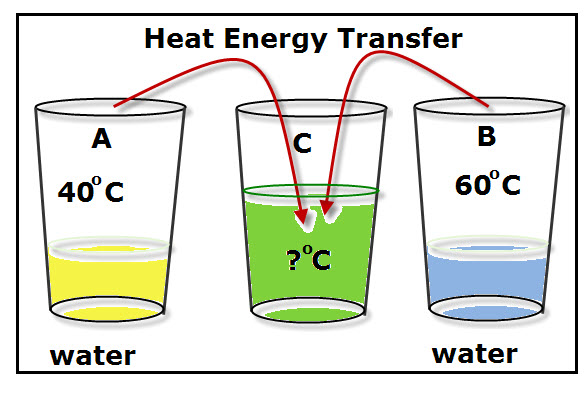 When heat energy is transferred from one substance to another, the heat energy moves from the hotter substance to the colder substance.
When heat energy is transferred from one substance to another, the heat energy moves from the hotter substance to the colder substance.
Temperature is a measure of how hot or cold a substance is. The higher the temperature of an object, the hotter is the object.
A thermometer is an instrument that measure how hot or cold an object is. In other words, a thermometer measures the temperature of an object.
 Anytime two substances with different temperatures come in contact with each other, there is an energy transfer. One substance loses heat energy and the other substance gains heat energy.
Anytime two substances with different temperatures come in contact with each other, there is an energy transfer. One substance loses heat energy and the other substance gains heat energy.
Heat energy flows from a hotter substance to a colder substance.
For example, if the ice cube in the diagram is placed in the container of water, there is an energy transfer. The hotter substance loses heat energy and the colder substance gains heat energy.
The water and its container lose heat energy and become cooler.
The ice cube gains heat energy and becomes warmer (this causes the ice cube to melt).
According to the law of energy conservation the total heat energy lost by the water and its container is equal to the total heat energy gained by the ice.
ENERGY LOST = ENERGY GAINED
Discover For Yourself
 The diagram represents the combination of two containers of water at different temperatures.The temperatures of the two containers of water are given as an example. Use water at any safe temperature. Lower the temperature of tap water with ice.
The diagram represents the combination of two containers of water at different temperatures.The temperatures of the two containers of water are given as an example. Use water at any safe temperature. Lower the temperature of tap water with ice.
Food coloring is used to color the cooler water yellow and the warmer water blue. The combination of these colors produces green water. The colors have a negligible affect on the heat transfer between the water molecules. If you find the colors distracting, omit the food coloring.
This activity allows kids to use a thermometer to measure temperature.
Hypothesis:
Ask kids to give a hypothesis about the temperature of the combined glasses of water.
Could the temperature of the two containers of water be averaged? (ONLY if the amount of water is exactly the same and the colder water is poured into the glass of warmer water–the third container has its own temperature that would have to be considered.–lots of variables.)
Does it matter how much water is being combined? (Yes. Give different examples, such as adding a cup of icy water to the water in a swimming pool.)
Best Possible Hypothesis:
The temperature of the combined water will be lower than the hot water and higher than the cold water.
Now kids can test their hypothesis.
Again, the temperature of the two containers of water.